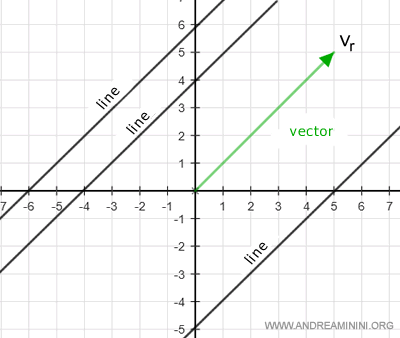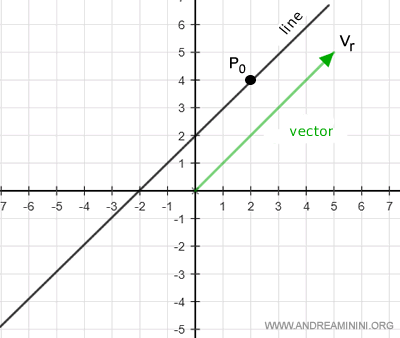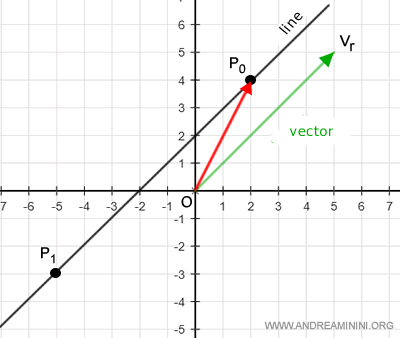Vector Representation of a Line
A geometric vector identifies a direction shared by all lines in the plane parallel to the vector.

Therefore, any line in the plane can be described by:
- a non-trivial geometric vector vr, known as the direction vector, which indicates the line's direction $$ v_r = \begin{pmatrix} l \\ m \end{pmatrix} $$
The parameters l and m are the line's directional parameters.
- a generic point P0 on the plane through which the line passes. $$ P_0 = \begin{pmatrix} x_0 \\ y_0 \end{pmatrix} $$
Example

A generic point on the plane belongs to the line if there exists a scalar alpha in R such that
$$ OP = OP_0 + \alpha v_r $$
Example
The point P1 has coordinates (-5,-3).

Point P1 belongs to the line if
$$ OP_1 = OP_0 + \alpha v_r $$
$$ \begin{pmatrix} -5 \\ -3 \end{pmatrix} = \begin{pmatrix} 2 \\ 4 \end{pmatrix} + \alpha \begin{pmatrix} 5 \\ 5 \end{pmatrix} $$
Solving the system of equations to check for a scalar alpha
$$ \begin{cases} -5 = 2 + \alpha 5 \\ -3 = 4 + \alpha 5 \end{cases} = \begin{cases} \alpha = - \frac{7}{5} \\ \alpha = - \frac{7}{5} \end{cases} $$
The system resolves with the scalar alpha -7/5
Indeed
$$ \begin{pmatrix} -5 \\ -3 \end{pmatrix} = \begin{pmatrix} 2 \\ 4 \end{pmatrix} + \alpha \begin{pmatrix} 5 \\ 5 \end{pmatrix} $$
$$ \begin{pmatrix} -5 \\ -3 \end{pmatrix} = \begin{pmatrix} 2 \\ 4 \end{pmatrix} + \begin{pmatrix} 5 \cdot ( - \frac{7}{5} ) \\ 5 \cdot ( - \frac{7}{5} ) \end{pmatrix} $$
$$ \begin{pmatrix} -5 \\ -3 \end{pmatrix} = \begin{pmatrix} 2 - 7 \\ 4 - 7 \end{pmatrix} $$
$$ \begin{pmatrix} -5 \\ -3 \end{pmatrix} = \begin{pmatrix} -5 \\ -3 \end{pmatrix} $$
We can generalize this result by stating that
All coordinates of all points on the line are characterized by the following equation, called the vector equation of the line: $$ \begin{pmatrix} x \\ y \end{pmatrix} = \begin{pmatrix} x_0 \\ y_0 \end{pmatrix} + \alpha \cdot \begin{pmatrix} l \\ m \end{pmatrix} $$Transforming the vector equation into a system of equations, we get the parametric equations of the line:$$ \begin{cases} x = x_0 + \alpha l \\ y = y_0 + \alpha m \end{cases} $$
There are infinite vector and parametric equations because there are infinite multiples of the direction vector.
Cartesian Equations
The vector P0P1 is parallel to the direction vector vr.
According to theory, a vector is parallel and proportional to another if
$$ \begin{pmatrix} x-x_0 & l \\ y - y_0 & m \end{pmatrix} \le 1 $$
This is verified if
$$ det \begin{pmatrix} x-x_0 & l \\ y - y_0 & m \end{pmatrix} = 0 $$
which, upon calculating the determinant, becomes
$$ m ( x-x_0 ) - l ( y - y_0 ) = 0 $$
This results in the Cartesian equation.
Again, there are infinite Cartesian equations.
